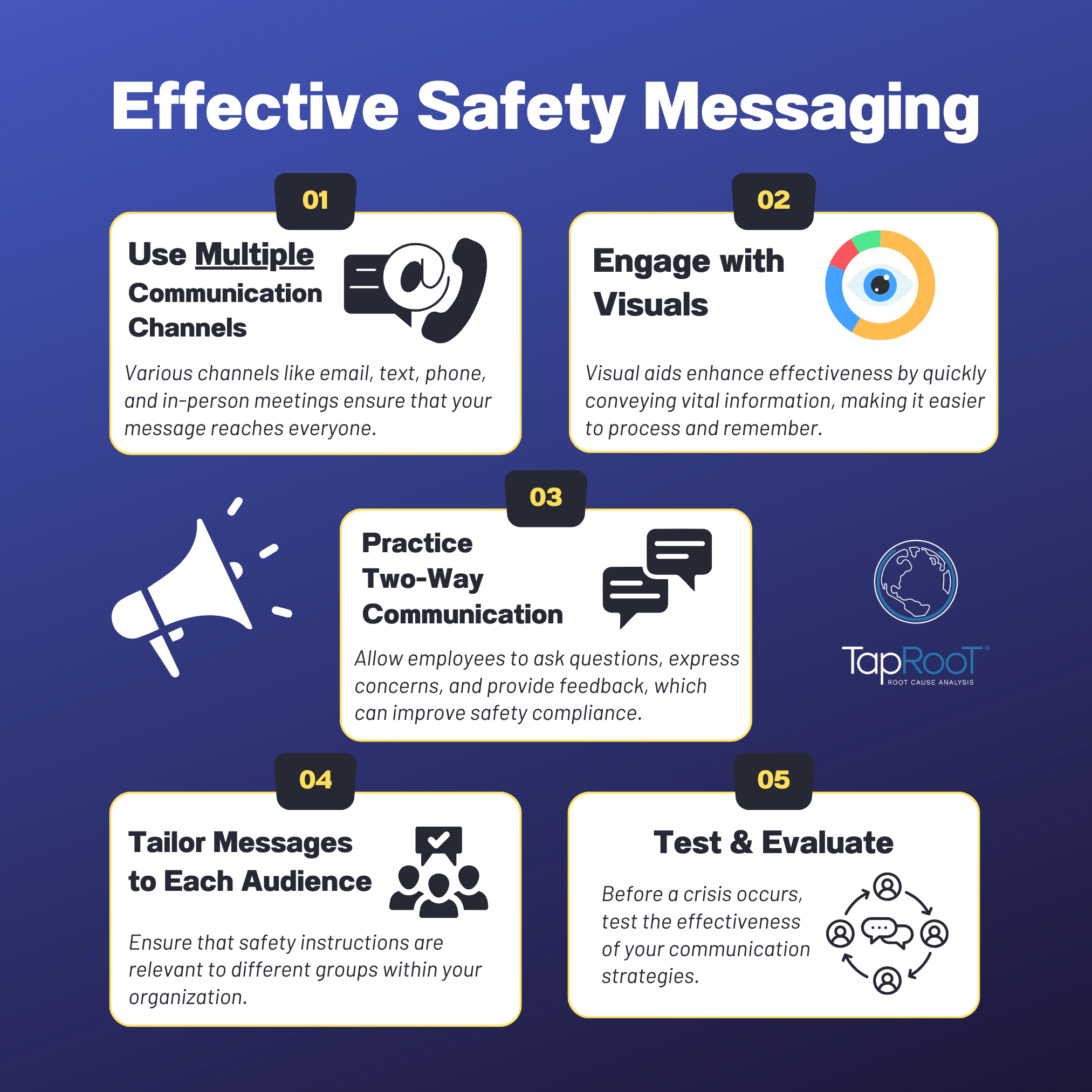Safety in Words: Crafting Crisis Messages that Save Lives

In today’s dynamic work environments, crises and emergencies can happen at any time. Maintaining workplace safety during crises, from industrial accidents to natural disasters and even health emergencies like pandemics, is paramount. One crucial aspect of ensuring safety during these situations is effective crisis communication.
Understanding the psychology behind safety messaging is key to conveying information that resonates with employees, prompts the right actions, and ultimately keeps everyone safe. In this article, we explore the psychological principles that underpin effective crisis communication in workplace safety and share best practices for crafting and delivering safety messages during emergencies.
Psychological Principles of Effective Safety Messaging
These strategies encompass clarity, urgency, emotional connection, trustworthiness, and consistency —all crucial elements for ensuring that your safety messaging reaches and resonates with individuals when it matters most.
Clarity and Simplicity
To ensure that safety messages are easily understood, using straightforward language and avoiding jargon or technical terms is important. Consider using short sentences and bullet points to convey important information. Additionally, provide clear instructions on what people should do to stay safe.
Urgency and Relevance
People are more likely to pay attention to messages that are perceived as urgent and relevant to their immediate well-being. Therefore, it’s important to emphasize the importance of the safety message and how it directly affects employees.
Emotional Appeal
Fear can be a powerful motivator in crises, but it should be balanced with empathy, reassurance, and a sense of community. Avoid overwhelming individuals with fear, but don’t downplay the seriousness of the situation either. Encourage individuals to work together and take care of each other.
Trust and Credibility
People are more likely to act on information from sources they trust. Therefore, ensuring that your safety messaging comes from a credible and authoritative source within your organization is important. Transparency is also crucial in building trust. Be honest about what is known and unknown, and provide updates as new information becomes available.
Consistency and Repetition
Repeating key safety messages is crucial. People must hear important information multiple times to remember and act on it. Consistency in messaging across different channels helps reinforce the message. Use different formats and styles to keep the messaging fresh and engaging but ensure the core message remains the same.
Crisis Communication Best Practices
The ability to convey safety messages clearly and persuasively is paramount during a crisis. People’s lives and well-being often depend on the information they receive, and how it’s presented can significantly impact their response.
1. Use Multiple Communication Channels
Recognizing that people have different preferences for receiving information is crucial. To ensure that all receive safety messages, it is recommended to employ a variety of communication channels. For instance, email, text messaging, phone calls, in-person meetings, and social media can all be used to reach a broader audience.
2.Engage with Visual Aids
Utilizing visual aids can enhance the effectiveness of safety messaging. Visual aids, such as infographics or clear, concise posters, can quickly convey vital information. This can make it easier for individuals to process and remember important safety instructions.
3. Encourage Two-Way Communication
Encouraging employees to ask questions, express concerns, and provide feedback fosters a sense of involvement and empowerment. This can significantly improve compliance with safety instructions and enhance overall safety in the workplace.
4. Tailor Messages to Each Audience
Organizational groups may have unique needs and concerns during a crisis. To ensure that safety instructions are relevant to the specific circumstances of each group, it is recommended to tailor messages to specific audience segments. This will help ensure that safety instructions resonate with the intended audience.
5. Test and Evaluate
Before a crisis occurs, running drills and simulations can test the effectiveness of communication strategies. Afterward, it is crucial to evaluate both successes and areas for improvement. This will allow for continued growth and development of safety communication strategies, ensuring they remain effective and relevant.

Catch Me in Action: Speaking at the TapRooT® Summit
I’m excited to share insights on this topic during Breakout Session 1, scheduled for Wednesday, May 1, from 11:30 AM to 12:30 PM EDT at the 2024 Global TapRooT® Summit at Horseshoe Bay Resort, outside of Austin, Texas!
I invite you to participate in my workshops and training sessions at the Summit. Join me to dive deeper into these valuable discussions and expand your knowledge. Your active participation will make these sessions even more enriching!
- EFFECTIVE INTERVIEWING AND EVIDENCE COLLECTION with Barb Carr
- Date: Monday, April 29 – April 30
- Time: 8:00 AM – 5:00 PM EDT
- PSYCHOLOGY OF A CRISIS: YOUR CRISIS MANAGEMENT PLAN
- Date: Wednesday, May 1
- Time: 1:30 PM – 12:30 PM EDT
- ADVANCED EI: EMOTION REGULATION IN DIALECTICAL BEHAVIOR SKILLS
- Date: Thursday, May 2
- Time: 2:20 PM – 3:50 PM EDT
- INVESTIGATIVE INTERVIEWING: THE PSYCHOLOGY OF NONVERBAL COMMUNICATION with Barb Carr
- Date: Friday, May 3
- Time: 9:00 AM – 9:50 AM EDT
Don’t miss these engaging sessions where you can gain valuable insights into psychology and enhance your knowledge in various fields.
Conclusion
Effective crisis communication in workplace safety is not just about conveying information; it’s about understanding the psychology behind how people process it. By following the psychological principles mentioned above and adopting best practices for conveying safety messages, your organization can better prepare its employees for emergencies and ensure that safety measures are understood and followed. In times of crisis, clear, empathetic, and authoritative communication can make all the difference in keeping everyone safe.
Additional Crisis Resources:
Feel free to contact me or follow me on LinkedIn for more TapRooT® RCA content.




